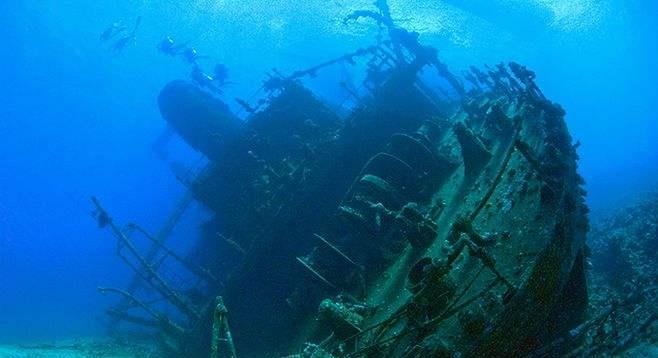A British man smashed 600,000 cultural relics in the South China Sea, making a profit of 200 million yuan, but we are helpless?
"The world's largest museum is at the bottom of the sea"
From the time humans sailed ships to the ocean, various shipwrecks occurred from time to time. In the vast sea, all kinds of dangers exist all the time, storms, reefs, pirates, at any time may lead to shipwrecks. As the busiest sea in the world, no one knows how many ships have traveled to and from the South China Sea, and no one knows how many ships have been buried at sea.
Among the ancient shipwrecks in the waters of the South China Sea, there are not only many Song and Yuan ships, but also many foreign ships. If you add shipwrecks from all over the world on the way back to China for trade, the treasures of shipwrecks in the South China Sea are even more numerous.

The colorful undersea shipwrecks recreate the style of the past, illustrating the grand economic and cultural exchanges between China and other countries in the world, and witnessing China's thousands of years of long history.
The value of these shipwrecks is also very shocking, such a huge treasure has made countless people yearn for it throughout the ages. Michael Hatcher, a British professional maritime treasure hunter, once salvaged two shipwrecks in the area, making tens of millions of dollars in profits.
Professional sea treasure hunter
In the 1980s, Mike Hatcher successfully salvaged an ancient Chinese merchant ship named Goethe Mårsen from the South China Sea.
In 1752, Goethe Malsen, loaded with porcelain and gold, sailed from Guangzhou to Amsterdam, the Netherlands. Soon after entering the South China Sea, the merchant ship sank and was never heard from again.
Mike Hatcher recovered 239,000 exquisite pieces of blue and white ceramics from the shipwreck, 125 gold ingots, each weighing 45 kilograms. Mike Hatcher sold the Hypertherm at an auction house in the Netherlands and made more than $20 million, which made him famous and profitable.
The same trick repeats
In May 1999, Mike Hatcher repeated the same trick, leading the Australian underwater salvage company to salvage water near the Belvedere Reef in the South Central Sea, the "Taixing" shipwreck was sunk in The second year of Daoguang, with a length of 50m, a width of 10m, weighing more than 1,000 tons, and producing 356,000 pieces of blue and white porcelain, which was examined by experts, most of the 356,000 pieces of blue and white porcelain produced by dehua kilns in the late 18th century and early 19th century.
These porcelains are mainly bowls, plates, plates, cups, spoons and other daily life food utensils, and their decorative patterns are mostly based on tree stones, orchid stones, ammonites, flower baskets, students' morning reading and other patterns, the layout is sparse, the brushwork is smooth, and it is full of elegant and refreshing folk life atmosphere.
In November 2001, the porcelain was auctioned in Stuttgart, Germany, with a total turnover of up to 30 million US dollars (equivalent to more than 200 million yuan in personal names).
Hatcher thus pushed the story of the treasure hunt in the South China Sea directly to the climax.
Despite the difficulties and even life-threatening salvage of the seabed, the huge profits have led professional salvagers to go to the bottom of the sea to find treasure despite the threat of death.
What is even more unimaginable is that in order to obtain more profits, these cultural relics dealers only care about treasures, and for the hulls and the remains of the victims, they are salvaged and scattered everywhere, and they often destroy half of the salvaged treasures, leaving only a small part, and then take them to auction.
In the case of Michael Hatcher, he actually salvaged nearly a million pieces of porcelain from the wreck of the Taixing, but in order to keep the price, he only picked out 356,000 fine pieces, and the remaining more than 600,000 pieces were artificially smashed. I don't know how many national treasures have fallen victim to this.
plight
Is there really nothing we can do to stop these acts and protect national treasures?
According to jurists, the definition of maritime cultural heritage is vague in both international and domestic law. At present, the relevant domestic cultural relics law stipulates that "cultural relics remaining in China's internal waters, territorial waters and waters under the jurisdiction of China in accordance with Chinese law, whether they originate in China or originate in foreign countries, belong to China." China shall have the right to identify the owners of cultural relics originating in China that remain in other jurisdictional areas other than China's territorial waters and in the high seas area."
However, in both theory and practice, such a legal definition is not accurate and perfect. For other seas outside China's territorial areas that can be identified as Chinese cultural relics, there is no "material principle" of cultural relics, which is obviously not conducive to the protection of China's cultural ownership. Some Western countries have adopted a dual principle, which is conducive to the recovery of their cultural relics.
It is a fact that China's laws in this regard are in urgent need of improvement, on the other hand, China's underwater archaeological surveys have also made great progress in recent years, and the salvage excavation of "Nanhai No. 1" is a good example. This is an ancient merchant ship from China's Song Dynasty, and archaeologists estimate that the value of the cultural relics unearthed by the whole ship will not be lost to the Qin Terracotta Warriors.
I believe that whether it is underwater archaeology or underwater cultural relics protection in China, it will get better and better in the future.